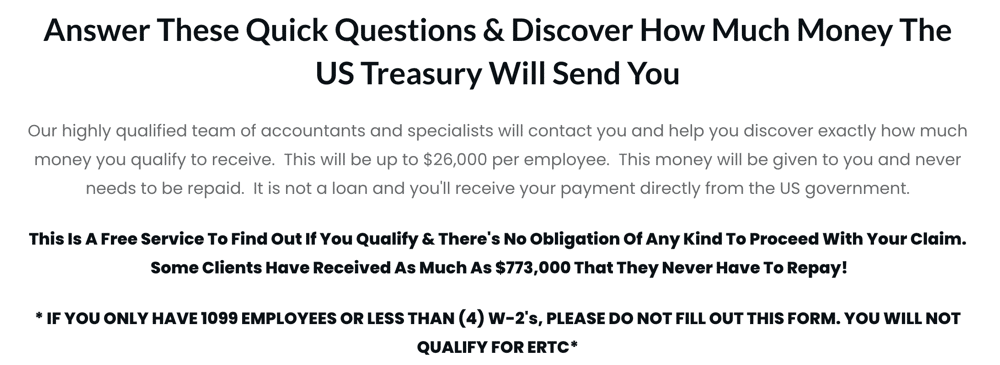Understanding the Covid Employee Retention Tax Credit
The Covid-19 pandemic has affected several businesses, leading to a decline in revenue and workforce reductions. In response, the US federal government introduced the Covid Employee Retention Tax Credit to incentivize employers to keep their employees on the payroll.
The tax credit offers a refundable credit for businesses that paid employees during the pandemic or experienced significant declines in gross receipts. This credit is claimed on the employer's tax returns and can be monetized by requesting a refund.
Eligibility for the Tax Credit
To be eligible for the Covid Employee Retention Tax Credit, businesses must have been fully or partially suspended due to a government order or had a significant decline in gross receipts.
Qualified Wages
The tax credit can be claimed on qualified wages paid after March 12, 2020, through the end of the program. However, it cannot be taken on wages forgiven under the Paycheck Protection Program (PPP).
For wages paid between March 13 and Dec. 31, 2020, businesses can claim the tax credit against 50% of qualified wages paid, up to $10,000 per employee annually. In 2021, businesses can claim up to $10,000 per employee per quarter, and the tax credit is equal to 70% of qualified wages paid.
Percentage of Qualified Wages
In 2020, businesses can claim up to 50% of qualified wages paid as a tax credit. In 2021, this percentage has increased to 70% of qualified wages paid.
The Covid Employee Retention Tax Credit is a significant relief for businesses affected by the pandemic. In the next section, we'll discuss how businesses can claim the tax credit.
How to Claim the Covid Employee Retention Tax Credit
Businesses that meet the eligibility requirements for the Covid Employee Retention Tax Credit can claim it by retroactively looking back on their payroll during the pandemic. Here's how to claim the tax credit:
Retroactively claiming the tax credit
Businesses can retroactively claim the Covid Employee Retention Tax Credit until 2024 or 2025. This means that businesses can conduct a lookback on their payroll during the pandemic and file an amended tax return to claim the tax credit.
Conducting a lookback on payroll
To conduct a lookback on payroll, businesses need to identify the qualified wages paid to each employee for each quarter. This includes the amount of qualified wages paid, the amount of the tax credit claimed, and the amount of social security tax paid.
Filing an amended tax return
Once businesses have identified the qualified wages paid, they can file an amended tax return to claim the Covid Employee Retention Tax Credit. Businesses should work with their accountant or payroll specialist to ensure that they are filing their tax return correctly and claiming the correct amount of tax credit.
Working with an accountant and payroll specialist
Claiming the Covid Employee Retention Tax Credit can be complex, and businesses are advised to work with their accountant or payroll specialist to ensure that they are claiming the credit correctly. These professionals can help businesses identify the qualified wages paid, file the amended tax return, and claim the correct amount of tax credit.
In addition, businesses should be cautious of third-party advice when claiming the tax credit, as the IRS warns. Penalty relief is available for claims related to the credit, but the director of the IRS has also warned taxpayers to be careful when claiming the expired Covid-19 employee retention credit (ERC), as the service is auditing and investigating false claims, according to Thomson Reuters.
In the next section, we'll discuss the potential risks associated with claiming the Covid Employee Retention Tax Credit.
Risks Associated with Claiming the Covid Employee Retention Tax Credit
While the Covid Employee Retention Tax Credit is a significant relief for businesses affected by the pandemic, there are also potential risks associated with claiming the tax credit. Here are some of the risks businesses should be aware of:
Double-dipping
One of the significant risks associated with claiming the Covid Employee Retention Tax Credit is double-dipping. Businesses cannot claim the tax credit for wages that have already been forgiven under the Paycheck Protection Program (PPP).
Inaccurate or fraudulent claims
Another risk associated with claiming the tax credit is inaccurate or fraudulent claims. The IRS is auditing and investigating false claims related to the tax credit, and businesses should ensure that they are claiming the credit correctly and have documentation to support their claims.
Working with promoters
Businesses should also be cautious of promoters touting refunds involving the Covid Employee Retention Tax Credit, according to the IRS. The IRS has warned that some promoters are offering to file false claims for businesses in exchange for fees or a percentage of the refund.
Penalty relief
If a business has claimed the Covid Employee Retention Tax Credit inaccurately or fraudulently, penalty relief may be available for claims related to the credit, according to the IRS. However, businesses should be cautious of third-party advice when claiming the tax credit, and work with their accountant or payroll specialist to ensure that they are claiming the credit correctly and have documentation to support their claims.
In the next section, we'll discuss how businesses can get started with claiming the Covid Employee Retention Tax Credit.
Getting Started with Claiming the Covid Employee Retention Tax Credit
If your business meets the eligibility requirements for the Covid Employee Retention Tax Credit and you want to start claiming the tax credit, here are the steps you should take:
Determine eligibility
The first step in claiming the Covid Employee Retention Tax Credit is to determine your business's eligibility. As we discussed in section 1, the tax credit is available to businesses that meet specific criteria, including a significant decline in gross receipts or a full or partial suspension of operations due to a government order. You can find more information about eligibility on the IRS website.
Identify qualified wages
Once you have determined that your business is eligible for the tax credit, you need to identify the qualified wages you paid to your employees during the pandemic. Qualified wages include wages paid between March 13, 2020, and December 31, 2020, and between January 1, 2021, and September 30, 2021. You can find more information about qualified wages on the Paychex website.
Calculate the tax credit
After you have identified the qualified wages paid to your employees, you need to calculate the amount of tax credit you can claim. The tax credit is equal to 50% or 70% of the qualified wages paid, up to $10,000 per employee annually for wages paid between March 13 and December 31, 2020, and up to $10,000 per employee per quarter in 2021. You can find more information about calculating the tax credit on the Synergi Partners website.
File an amended tax return
Once you have calculated the amount of tax credit you can claim, you need to file an amended tax return to claim the Covid Employee Retention Tax Credit. You should work with your accountant or payroll specialist to ensure that you are filing your tax return correctly and claiming the correct amount of tax credit.
In the next section, we'll discuss some tips for businesses that want to maximize their Covid Employee Retention Tax Credit.
Tips to Maximize Your Covid Employee Retention Tax Credit
If your business is eligible for the Covid Employee Retention Tax Credit, there are some tips you can follow to maximize the amount of tax credit you can claim. Here are some of those tips:
Keep accurate records
To claim the Covid Employee Retention Tax Credit, you need to have accurate records of the qualified wages paid to your employees during the pandemic. You should keep documentation, such as payroll records, that show the amount of qualified wages paid, the amount of the tax credit claimed, and the amount of social security tax paid.
Work with your accountant or payroll specialist
Claiming the Covid Employee Retention Tax Credit can be complex, and working with your accountant or payroll specialist can help ensure that you are claiming the credit correctly and maximizing the amount you can claim. These professionals can help you identify the qualified wages paid, file the amended tax return, and claim the correct amount of tax credit.
Take advantage of penalty relief
If you have claimed the Covid Employee Retention Tax Credit inaccurately or fraudulently, penalty relief may be available for claims related to the credit, according to the IRS. Penalty relief can help mitigate the risks associated with claiming the tax credit, but businesses should ensure that they are claiming the credit correctly and have documentation to support their claims.
Be aware of double-dipping
As we discussed in section 3, one of the significant risks associated with claiming the Covid Employee Retention Tax Credit is double-dipping. Businesses cannot claim the tax credit for wages that have already been forgiven under the Paycheck Protection Program (PPP). To maximize the amount of tax credit you can claim, you should ensure that you are not double-dipping.
Stay up to date on changes to the tax credit
The Covid Employee Retention Tax Credit has gone through several changes since its inception, and it's important to stay up to date on any changes to the tax credit that could impact your business. You can find more information about changes to the tax credit on the IRS website.
By following these tips, your business can maximize the amount of Covid Employee Retention Tax Credit you can claim and mitigate the risks associated with claiming the tax credit.
In the next section, we'll wrap up this article and summarize the key takeaways.
Conclusion: Important Takeaways
Businesses affected by the pandemic can benefit greatly from the Covid Employee Retention Tax Credit, but there are also possible risks involved in claiming the tax credit. The key takeaway from this article are listed below:
- Businesses that adhere to specific requirements, such as a sharp decline in gross receipts or a full or partial suspension of operations as a result of a government order, may qualify for the Covid Employee Retention Tax Credit.
- Under the Paycheck Protection Program (PPP), businesses are not eligible for the tax credit for wages that have already been forgiven.
- Businesses should make sure they are claiming the credit properly and have proof to support their claims because inaccurate or fraudulent claims related to the tax credit could result in penalties.
- Working with your accountant or payroll specialist can help you make sure you are claiming the credit correctly and amending the amount you can.
- Keeping up with changes to the tax credit can help you seize any new opportunities to maximize the amount you can claim.
Your company can maximize the amount of tax credit you can claim and prevent penalties by heeding these recommendations and being aware of the risks associated with claiming the Covid Employee Retention Tax Credit.
We appreciate you reading this article. Check out our other excellent content on ertcguy.com if you found this information helpful.
Frequently Asked Questions
Question: Who is eligible for the Covid Employee Retention Tax Credit?
Answer: Businesses that had a decline in gross receipts or were partially or fully suspended.
Question: What is the maximum amount for the Covid Employee Retention Tax Credit per employee?
Answer: $10,000 per employee annually for 2020 and $10,000 per employee per quarter in 2021.
Question: How can businesses claim the Covid Employee Retention Tax Credit?
Answer: By filing an amended tax return and working with an accountant or payroll specialist.
Question: Who can help businesses claim the Covid Employee Retention Tax Credit?
Answer: Accountants and payroll specialists can help businesses claim the credit correctly.
Question: What is the penalty for claiming the Covid Employee Retention Tax Credit inaccurately?
Answer: Businesses may face penalties if they claim the credit inaccurately or fraudulently.
Question: How can businesses avoid double-dipping when claiming the Covid Employee Retention Tax Credit?
Answer: By ensuring that they are not claiming the credit for wages already forgiven under PPP.




